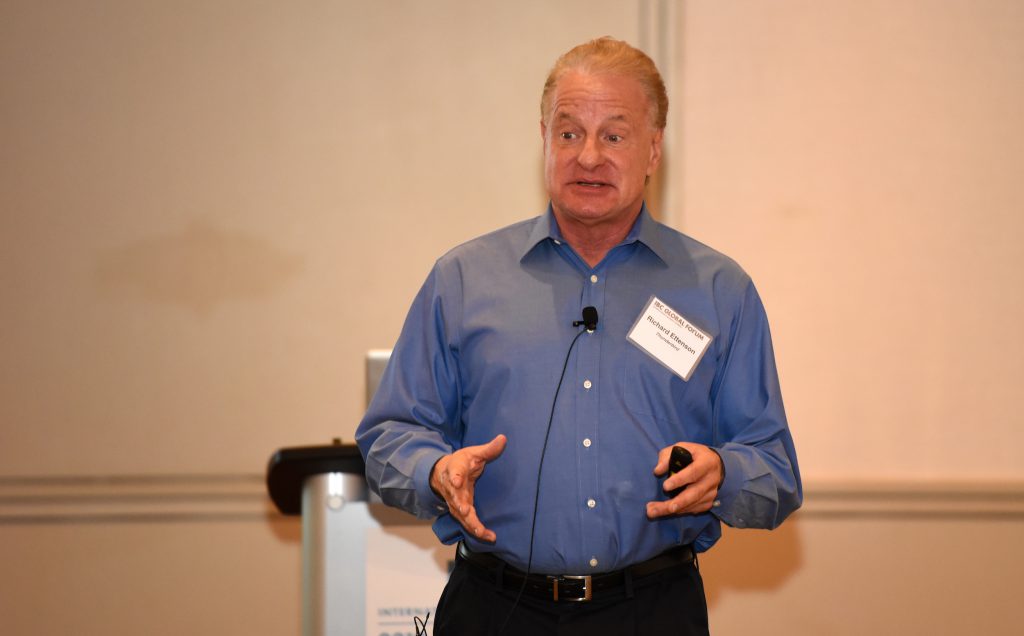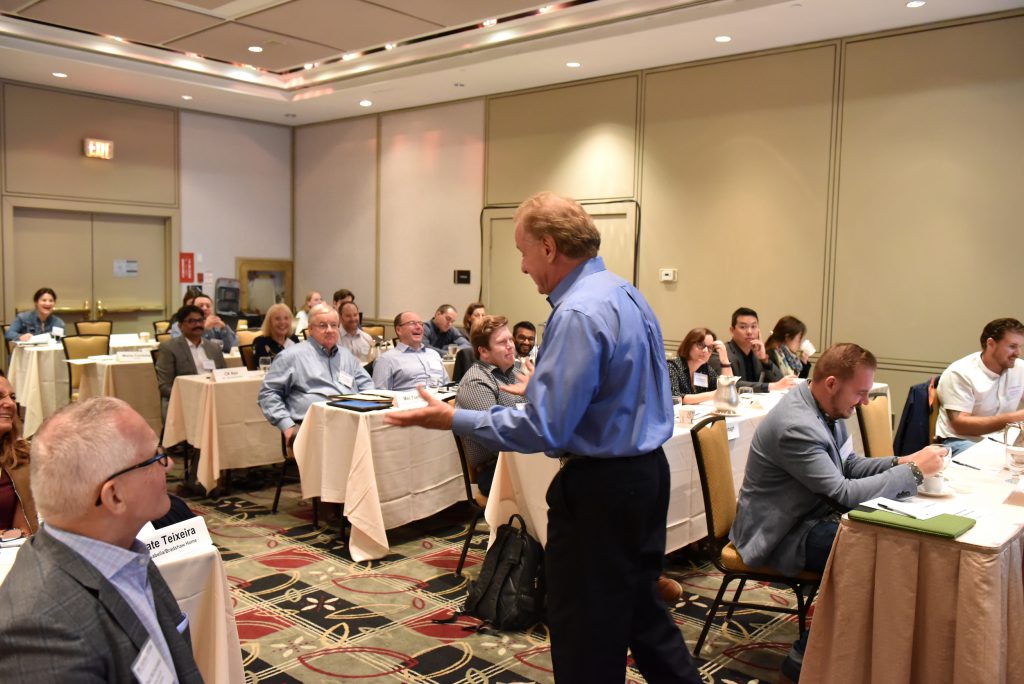2018 Global Forum Recap: Thunderbird School of Global Management
Richard Ettenson, Ph.D., Professor and Keickhefer Fellow of Global Marketing and Brand Strategy at Thunderbird School of Global Management, offered a two-part Executive Education session that outlined key topics to consider when entering global markets. He engaged participants with questions and encouraged conversations, and included stories about successes and failures in varied product categories, market segments and countries.
Dr. Ettenson is also a senior partner at Type 2 Consulting, a New York-based business strategy and brand consultancy. His extensive corporate learning and consulting experience informs the programs he has delivered on five continents to senior executives from a wide range of top global enterprises. Author of nearly 100 articles, book chapters and academic journals. He has also served as an advisor/lecturer at universities in China, Russia and numerous European countries. Dr. Ettenson and his family are dual citizens of the U.S. and Australia.
Ettenson began the deep dive into complex issues with a simple acronym for operating in today’s business landscape: VUCA. Everyone is facing a world that is Volatile Uncertain Complex Ambiguous.
Recognizing these factors should guide thinking to prepare for what’s coming.
He summarized his approach and the broad business context of the related topics he would address:
Strategies for large organizations vs. small companies
- Your imperative for growth – where to find opportunities?
- Making informed growth decisions
- Challenging the conventional wisdom
- Failure rate of new products/new initiatives
- New thinking and new assessment tools for managers and companies to help them increase the likelihood of international business success
- Small group/company exercises
Sources of Business
Identify ways to grow and find opportunities for how to influence customer behavior to get new people to use your products.
- Capture new users in your current category
- Grow with your existing customers. They already know you and like you. Increase the frequency/volume of what they buy. Consider brand extensions.
- Grow the category. This will increase competition; identify reasons to buy from you.
- Increase share in a mature market with flat growth. Price competition is not sustainable.
Your Role as an Innovation Leader
Today business leaders recognize that every company must innovate or die. Everything is moving faster as mobile phones become available in emerging economies. Discover new market opportunities and new users as connections speed to 4G. Companies must create value in a changing and fiercely competitive business environment, while growing in a reliable and sustainable way.
Is the domestic market sufficient to ensure your path to growth? Do you also have overseas (global) ambitions? Should you have overseas (global) ambitions?
Recent global research reveals that a key to overseas success is “closer to home” than you might think.
In order to make informed strategic decisions we need to look at the bigger picture and understand change. Realize that the “conventional wisdom” is assumed to be true, but often is not.
Begin with a PESTE Growth Analysis that studies these aspects of the target markets:
- Politics and legal
- Economics
- Social/cultural
- Technological
- Environmental

Differences between Domestic vs. International Marketing
Domestic:
- Research in one language and easy to access
- Transactions in single currency
- Head office employees possess knowledge of home market
- Promotional messages consider a single national culture
- Market segmentation in a single country
International
- Research data in foreign languages and difficult obtain and interpret
- Fluctuating exchange rates
- Head office personnel might have only basic information of foreign markets
- Numerous cultural differences
- Market segments might be defined as same type of consumer across several countries, such as the global youth culture. Economies of study will reach similar consumers across several markets.
After the launch of a global effort, when managers are asked if they met the business performance objectives for the overseas initiatives, too many answer, “Not quite” or “Not at all.” They will usually point to externalities, such as shifting market conditions, unexpected channel complexity or aggressive competitors. But the root cause often lies closer to home and becomes evident once the corporate culture is analyzed and understood.
The failure rate of new businesses is generally very high—in the unacceptable range compared to other business success standards. In the next portion of his presentation, Ettenson promised to introduce a new tool that would prevent landing in the New Business Graveyard.
PART TWO
A New Business Assessment Tool
After a short break, Ettenson suggested that in order to set its priorities for a global business initiative, a company must develop “The Seven ‘Tudes of International Expansion”– a diagnostic framework he and his team introduced in a 2016 article published in the Harvard Business Review. He explained the “’Tudes” with numerous examples and outlined how a company can engage in a process with all stakeholders to score itself on these characteristics. This exercise can identify areas that need work before a company embarks on a costly international expansion. Scores can predict the probability of success or failure.
- Attitude: the priority a company or division places on global business expansion
- Aptitude:the right experiential resources to succeed abroad
- Magnitude: the ability to align the scale and scope of the overseas opportunity with the company’s goals and capabilities
- Latitude: the willingness to adapt company policies and practices to the opportunity
- Rectitude: legal and ethical practices that allow for market success while maintaining corporate compliance
- Exactitude: a corporate culture that tolerates ambiguity and uncertainty both with and without “the numbers”
- Fortitude: corporate commitment to global initiatives in general, even in the face of setbacks
He challenged listeners to analyze their own companies’ attitudes and behaviors by using worksheets he distributed. Then he invited participants to share their scored attributes with the person seated beside them to learn from the experience of people working in varied product categories, countries and challenges faced by organizations of differing sizes.

Research Results
After the Global Forum participants had analyzed their own companies and engaged in this discussion with a partner, Ettenson revealed the results of his research. This section of the presentation allowed participants to reflect on how their perceptions of their company’s characteristics compared with the scores of companies that had engaged in this study.
Ettenson’s research sample included 301 global business professionals, all with extensive international experience (20+ years on average), knowledge and direct experience with recent overseas expansion initiatives. These top-level executives held positions in all functional areas at B2B and B2C companies.
Participants were sorted into two groups: successful and unsuccessful expansion efforts that met business performance objectives such as sales, profit, and/or market share. The analysis revealed shared characteristics of organizations with successful results.
Applying the “’Tudes” Business Assessment
By using this diagnostic measurement tool, a company can identify action steps to educate team members, modify strategies, products or opportunities. Companies that leverage the full value of the tool employ the following steps:
- All stakeholders in the initiative complete the tool
- Determine degree of consensus among key players
- Consider the overall Seven ‘Tudes Score
Use this tool for a diagnostic “reality check” to determine your overseas readiness before pursuing an international expansion. Companies now can identify in a systematic manner specific internal shortcomings that are not always obvious, but individually, and collectively, have the potential to derail an attractive overseas opportunity before it has a chance to leave the station.



